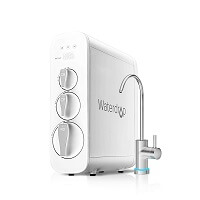The first step in understanding the working principle of reverse osmosis is to know what osmosis is all about. Osmosis explains the natural behavior of water – how it always strives to achieve equilibrium.
For instance, if there is a cup, and in the cup, there is a thin piece of waterproof clothing partitioning it into two sections of the same size. The clothing is the “semipermeable membrane.” Now let’s assume we fill each section with equal amounts of fresh water and saltwater.
You would notice that the water level on the saltwater compartment will continue to rise. This is because the freshwater moves to the saltwater section (the more concentrated solution) through the membrane. The movement confirms the nature of water to always look for equilibrium; it is moving to ensure there is an equal amount of salt in both sections.
In reverse osmosis, pressure comes into play, and the common water contaminants replace the salt in our example.
Reverse Osmosis Filtration Experienced
Reverse osmosis describes the application of pressure to a highly concentrated solution, forcing it to a lower concentration membrane through a membrane. The contaminated water is the highly concentrated solution while the uncontaminated water is the lower concentrated solution.
There are two water solutions here – one is highly concentrated with contaminants, and the other is the uncontaminated water free of contaminants and fit for drinking. A semipermeable is key to achieving effective reverse osmosis filtration. It removes inorganic solids, including salts and other harmful contaminants and chemicals, from water.
The Process of Reverse Osmosis
When the unclean water is pressured, it passes through a semipermeable membrane, which is also called the reverse osmosis membrane. The membrane has pores of a definite size, which are just big enough to allow water molecules to pass through them. This means that every other component apart from the water molecules, including dissolved salts, organics, bacteria, and pyrogens, is trapped.
The first step in reverse osmosis is increasing the pressure of the water above the normal osmotic pressure. A high-pressure pump helps to achieve this. The water easily demineralizes or deionizes with the additional pressure, thus separating the pure water from the contaminants. These separated components then pass through the semipermeable RO membrane.
Once the feed water gets into the membrane under pressure, only water ends up passing through while the contaminants and other impurities are trapped and sent to the brine or reject stream. The water that passed through is the filtered water or product water or permeate, free of up to 99% of contaminants and dissolved salts. The other part that the membrane restricts is the concentrate.
While the standard filtration process keeps the trapped contaminants within the filter, reverse osmosis adopts a cross-filtration method with two terminal outlets, each for the contaminant and the filtered water. So, there is an outlet each for both the wastewater and the filtered water. The wastewater is not accumulated because the system washes the contaminants away and maintains relatively high turbulence so that the RO membrane surface remains clean.
The Differences Between Reverse Osmosis and Traditional Filtration
The major difference between traditional filtration techniques and reverse osmosis filtration is the presence and capability of the membrane. You get pure water from your faucet because of the rate at which the water goes through the membrane.
Traditional filters rely on individual substances to remove impurities. We have created a list of such substances (filtration materials) below, each with its pros and cons. This list can guide you to decide the best filtration style for your use.
- Activated Alumina – Effective against fluoride but may add a metallic taste to the water.
- Activated Carbon – It is relatively affordable and effective against chlorine. It cannot remove dissolved inorganic compounds.
- Ceramic Filters – Despite being cheap and easy to use, it is slow in performance.
- Ultraviolet Purifier – It can remove bacteria. However, it costs more and may increase your electricity bill.
- Water Distillation – It is effective against bacteria and contaminants but requires electricity to work and takes several hours to filter water.
Reverse Osmosis Filtration relies on an activated carbon filter to remove contaminants. It also gets rid of leftover dissolved inorganic compounds that can harm you. You can determine the effectiveness of your RO filtration system relative to traditional water filtration by checking the micron rating scale.
Micron Rating Explained
The micron rating describes the average size of the openings in a filter. A higher micron rating means the filter will allow larger substances to pass through. Micron is the one-millionth of a meter and is often used as a unit of measurement in science and tech.
The filter in RO systems has a micron rating of 0.0001 microns, which means they can remove contaminants bigger than that. On the other hand, carbon filters have a micron rating of 0.5, i.e., they can only remove contaminants larger than that.
What Reverse Osmosis Filters Remove?
RO systems are effective against dissolved solids, such as fluoride and arsenic. Asides from the RO membrane, there are usually sediment and carbon filters, offering a broad spectrum of reduction. The carbon filters effectively against chlorine, bad odor, and taste, while the sediment filter deals with the debris and dirt.
Some of the contaminants that constitute the 99% of impurities RO systems remove from water include:
- Fluorine and chlorine
- Nitrates, sulfates, and other salts
- Cadmium, barium, chromium, arsenic, lead
- Rust, dirt, and sediments
- Volatile organic compounds (VOCs)
- Parasites
- Pesticides, herbicides, and heavy metals
- Total dissolved solids (TDS).
Finally, it removes bad taste and odor and makes water colorless.
Advantages of Reverse Osmosis Filtration
It improves your diet.
Reverse osmosis provides you with tap water even if you are on sodium-restricted diets. In addition, the RO filtered water is safe to drink and can be used in cooking, whether to wash ingredients or as boiling water.
It offers flexibility.
The safety RO filters offer is not dependent on the water source. So whether yours is the municipal water or water from a private well, RO systems can filter it. The filtration process removes dissolved solids in well water and the excess water treatment chemicals used in municipal water.
It is convenient.
You can easily install a reverse osmosis system without any additional help. The design is compact, requiring a little under sink or countertop space.
Factors affecting the performance of RO systems
A reverse osmosis water system may tick all the necessary boxes and still not perform optimally. This is because the optimal performance of an RO system depends on a couple of other factors, including salt concentration, recovery, pressure, and temperature.
Pressure – Increased feed water pressure is necessary to increase the permeate flux and decrease the dissolved solid content of the permeate.
Temperature – Increased temperature helps to increase the permeate flux and salt flow.
Recovery – This is the relation between the permeate flux and the pressure of the feed water. It is a direct relation, so when the percentage recovery increase, the natural osmotic pressure increases, alongside the concentration of the salts in the residual fed. This leads to an overall decrease in salt retention.
The salt concentration of the feed water increases as the osmotic pressure increases. So, if the pressure stays constant, an increase in salt concentration will lead to a lower membrane water flux.
pH tolerance can also contribute to the performance of a RO filter, but this works differently across various kinds of RO membrane.
In Conclusion
We are confident that you now know more about reverse osmosis, its relationship with traditional filtration, and how the process helps to get rid of harmful contaminants in water.

